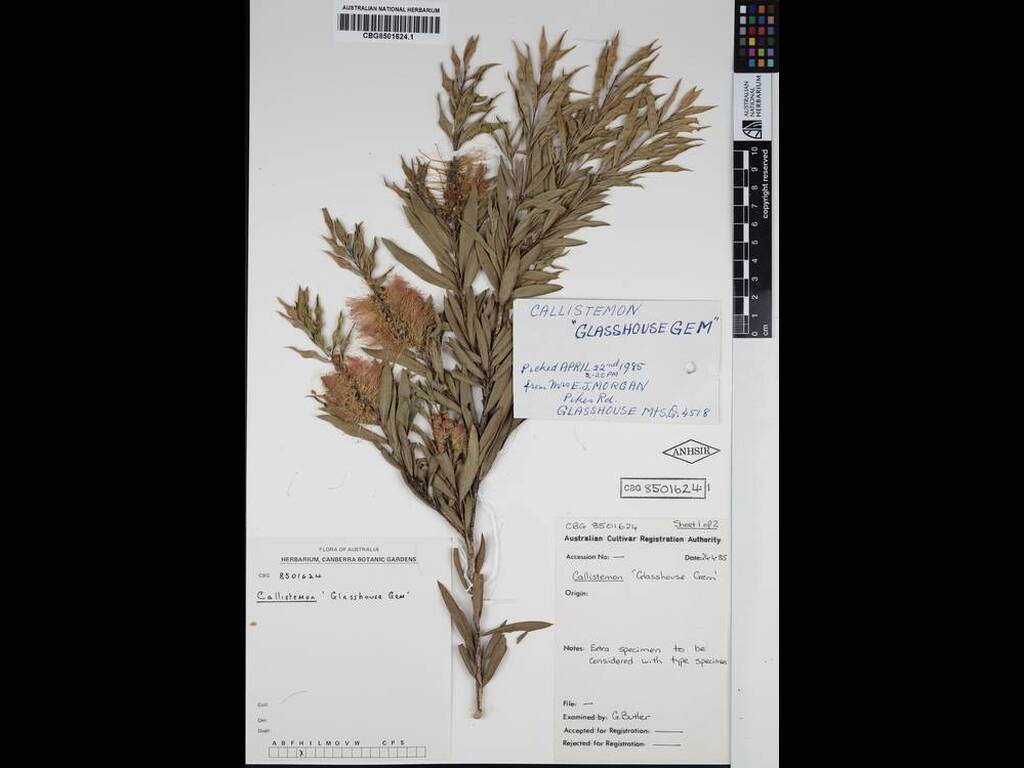Callistemon 'Glasshouse Gem'
- File Number
- 358
- ACRA Field Book Number
- 152
- Registration Date
- 29/10/1987
- Application Received
- 01/03/1985
- Family
- Myrtaceae
- Cultivar Name
- Callistemon 'Glasshouse Gem'
- Origin
- Callistemon'Glasshouse Gem' is an F2 selection from a hybrid cross between Callistemon sp. (Tinaroo) and C. salignus. A selection was made from a number of seedlings germinated from seed taken from a Callistemon sp. (Tinaroo) plant in the mid 1960's. Seed was subsequently collected from one of these original plants, one of these seedlings being Callistemon 'Glasshouse Gem'. The name "Glasshouse" refers to the Glasshouse Mountains district of Queensland where the cultivar was first selected. The cultivar was first received by the Authority in March 1985. Registration applied for by Mrs EJ Morgan of Pikes Road, Glasshouse Mountains.
- Characteristics
- This cultivar can be expected to reach 3-5m tall by 1.5m wide. The growth habit is very upright. The trunk is covered in a soft, fissured grey bark that is papery underneath. Older foliage is rather stiff and prickly while the younger growth is a deep pink and is covered by silky hairs. The young foliage is the main feature of this plant. The fower spikes are ca. 50mm long and are produced in spring and autumn with occasional flowers during summer. Diagnosis: This plant closely resembles C. salignus in most respects and it is extremely difficult to distinguish it. The hybrid origin is known only because the original seedlings were raised from seed taken from Callistemon sp. (Tinaroo). The leaves are slightly smaller than is usual for C. salignus, being up to 55 mm long though often smaller. The ultimate height is also smaller, with 3-5m being the maximum height. The bark is soft and fissured on the outside with papery bark underneath as compared to the wholly papery bark of C. salignus. The filaments are a dark pink in colour at anthesis, becoming lighter in colour with age. Otherwise, the general appearance is very similar to C. salignus.
- Cultivation
- The cultivation conditions required are as for C. salignus. Propagation of this plant must be by vegetative means to ensure retention of the cultivars features. The plant is tolerant of drought. Frost hardiness is not known though is likely to be similar to C. salignus.
- Publication
- Cornford, C. (1993), More Callistemon Cultivars. Australian Plants 17(134): 62
- Colour Coding
- RHS Colour Chart 1966new growth: near red group 47Aslightly older growth: yellow green group 152D to 145Amature growth: yellow green group 147Bfilaments: near red group 38B
- Propagation
- Cuttings
- Applicant Name
- Mrs E.J. Morgan
- Uses
- As part of a mass planting or mixed in a shrubbery, or as a spectacular feature plant.
- Availability
- Unknown
- ANBG Accession Numbers
- ACC358; ACRA234/152/155; CBG8700505/8501501/8501624.
- NSL ID
- -

